This post may contain affiliate links.
Guppies should do fine in outside pots, ponds, or other containers in a tropical climate. They are very easy to keep, and depending on your set-up need almost no maintenance. Finding a suitable pot or container to keep guppies outside can be tricky, we’ll talk about that, also about maintaining water temperature, filtration, water plants, and keeping different types of fish together.
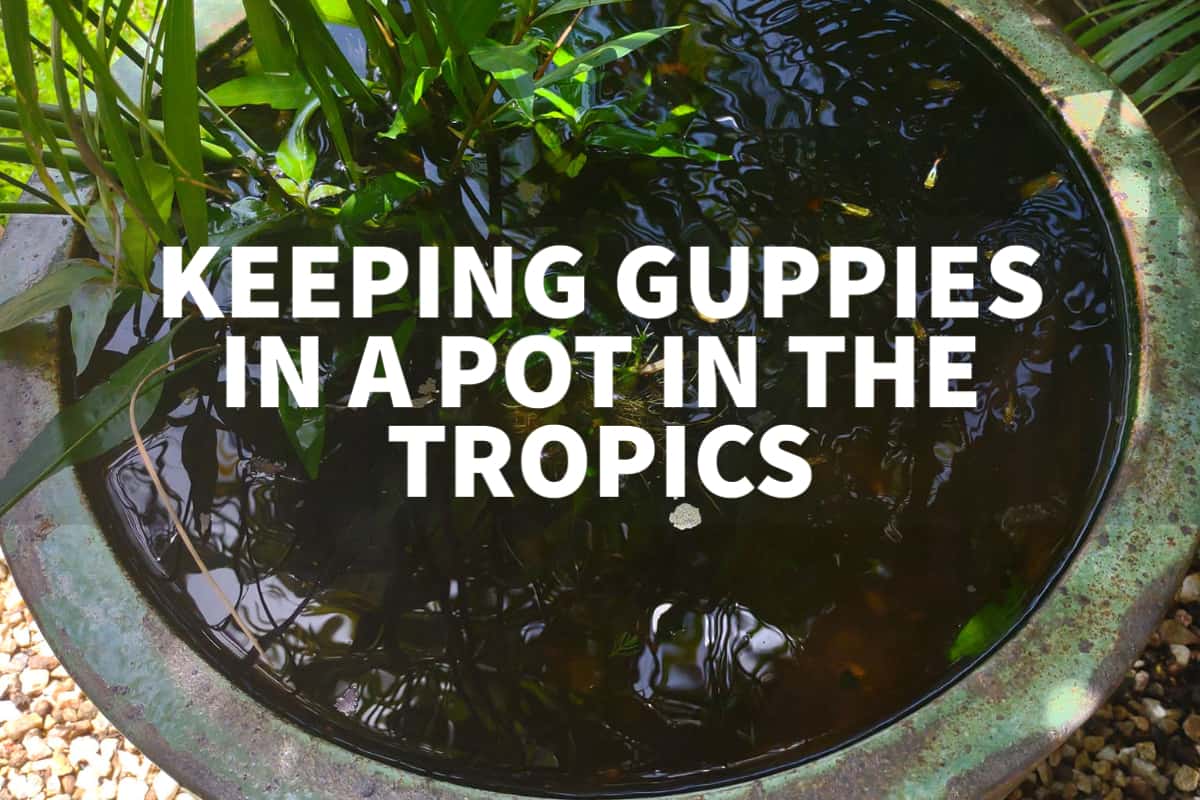
I’ve had my guppies (plus platys and shubunkins) outside in a glazed terracotta pot for years now. I enjoy them, they breed (and die) freely and we’ve had no problems with mosquitos. We have had problems with other predators and you may need to protect your fish in some way.
Guppies breed prolifically and you need to be certain you don’t have too many fish for your volume of water.
Also, remember that warm water holds less oxygen than cool water. Your guppy’s health, lifespan, breeding, and activity could be affected by low oxygen levels.
A simple solar aerator (oxygenator) like this one, is likely to help with this. They’re cheap to buy and easy enough to set up.
Update late: We do own a bubbler or oxygenator like the one above and it recently averted catastrophe when the water in the pot started to turn bad. This came about because of a rotting plant, anything rotting in a small pot or pond will extract oxygen from the water. A good sweep with a small aquarium fish net with extending handle (essential if you plan to keep guppies), removing the dead vegetation, and switching on the bubbler, and no lives were lost!
I have never had to clean out this mini pond and so far the plants have done a good job of keeping the ceramic pot water clear and clean. You could add an aerator, I have one. That said, the water very rarely gets smelly, other than when I’ve cut the plants back too hard.
The water will evaporate, you will need to keep topping it up. You can use tap water for your fish but you either need to add a chemical to remove chlorine and other contaminants that could harm your guppy fish, or you need to let the water stand. Rainwater or bore water would probably be better.
Keeping Guppies Outside
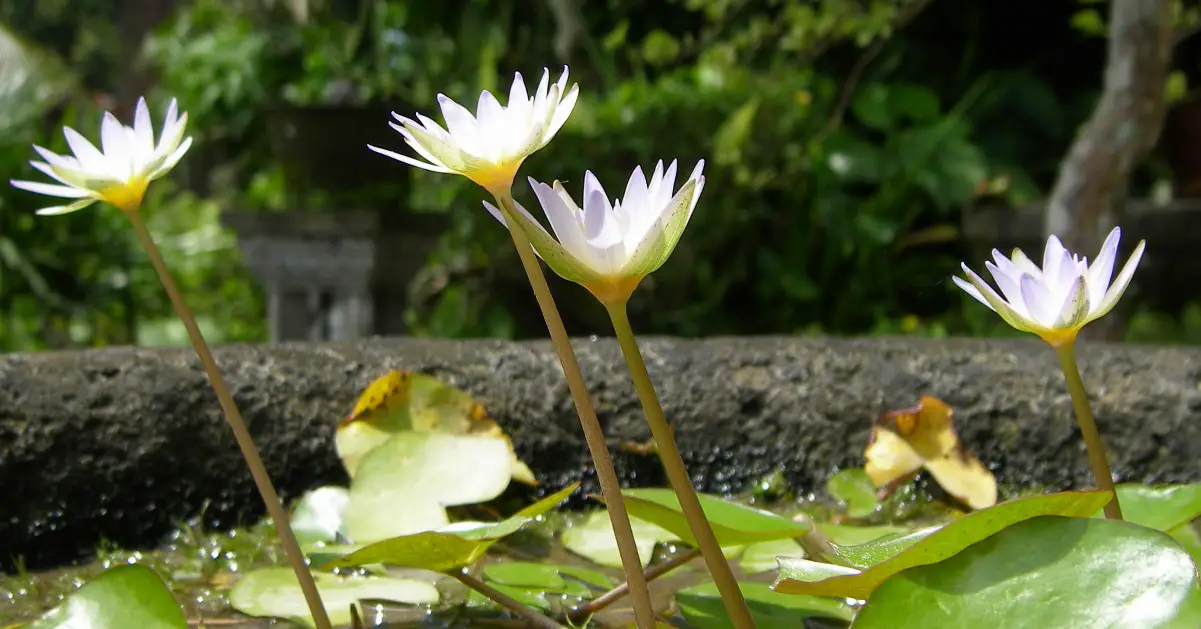
Yes, guppies can live outside if you have a warm to tropical climate. Read on to find the temperatures at which guppies can live outside in a lotus pot or pond.
You need to be mindful of the temperature for guppy keeping outdoors. Guppies, being a tropical fish species like to stay between approximately 72 and 82 °F or 22 and 28 °C) range. They can cope with the odd cooler night. You can check the exact specifications here.
Remember that a large body of water will hold its heat to an extent. This means that overnight the water temperature should drop more slowly than the air temperature.
Also if your guppie pot is near, for instance, a solid wall which holds the heat, it is likely to stay warmer than one in an exposed spot.
Don’t put your outdoor guppie pond or pot in full tropical sunshine, they could heat up too much. I’d tend to put them where they get some shade or catch the morning sun to warm up faster.
If it gets too cold where you live (below about 60 °F or 15 °C ) you may need to think about installing a heater or moving them indoors in winter.
You can also use water plants to shade your fish pond or pot slightly.
Where we live in the tropics we can see temperatures this cool at night, our fish have been OK. Shubunkins, being goldfish, prefer cooler temperatures but these temperature ranges do overlap. Again, we’ve had no issues with it being too cold for the guppies to live outside.
The shubunkins are huge and there may be danger of them eating small guppy fry now. We’ve had no problems keeping shubunkins, guppies, and platys together in an outdoor pot so far.
The platys seem to be more disease resistant than guppies. They die less often. The guppies are prone to death somewhat.
What Are Guppies?
Guppies are small tropical fish, (Poecilia reticulata or Lebistes reticulatus) Guppies are colourful and come in many colours, they are live-bearing freshwater fish of the family Poeciliidae, popular as a pet in home aquariums, tanks, bowls, pots and ponds. Guppies are native to South America and you’ll find them in the Amazon river. I’ve also seen guppies living in rivers in North Queensland Australia, no doubt deliberate, or accidental, released pets. This is not allowed and you should be very careful not to allow your guppies to get into natural water systems.
Guppies can be useful in controlling mosquitos or as ornamental pets.
Keeping Guppies in Glazed Pots
The pot you choose must be fully glazed inside and out and the glaze must be complete, with no flaws or cracks. This is what I was told by a fish & terracotta pot expert. He sealed the hole in the bottom of the pot for me using a marine sealant and it has never leaked.
You can buy ceramic pots for fish keeping outdoors without the hole in the bottom, but in our experience, these are a lot more expensive and hard to find.
Other people use pond liners or plastic containers, old sinks, and bathtubs.
We were aiming for an Asian look, a style similar to something you’d find in Bali or Thailand.
The cost of the pot and getting it sealed was under $200 (Australian dollars, United States, $131, but I suspect they would be cheaper in the US, most things are.) for us. We then just had to buy fish, plants, sand, soil-less compost, and fish food. The total cost was under $300 (Australia) and the fish breed prolifically.
Can Guppies Live Outside in the US?
Guppies can live outside in a lotus bowl, pot, or pond in the United States if night temperatures don’t get below about 60F, although the odd cold night should be OK, sustained cold won’t be good for outdoor guppies. These temperatures can’t really be found in US gardening zones, not even zones 9 and 10 stay this warm, but if you have a particularly warm spot with a good heat sink (a stone wall for instance), you may get away with it. Otherwise you’ll need to keep your guppy pot in a greenhouse or similar warmer place. Submersible heaters are available for fish pots, tanks, bowls and ponds and these, plus insulation, may help if you’re in a colder climate. Take a look here.
Protecting Outdoor Fish From Predators
Unfortunately, a lot of creatures will want to eat your fish. These include rats, snakes, cane toads, butcher birds, kingfishers, and cats. We’ve found it necessary to keep the top covered in landscaping fabric or aviary mesh (small mesh wire fence material) or you could use netting.
We’ve seen birds take our fish. They are quite brazen.
It’s a pity as it stops the local frogs from using this water source. But we want to keep our fish.
The aquatic tropical plants in the pot go some way to providing hiding places for small guppies. You could even take your guppy-keeping a step up and go into small, ornamental aquaponics setups like this guppy tank.
Your guppies could be growing food, particularly herbs. The fish’s excrement feeds your plants, the plants clean the water in a circulating system. One of the benefits of growing your own food is to save money. These set-ups are quite expensive, so I’d be inclined to make a DIY version for cost-effectiveness.
Plants for Ponds in Pots
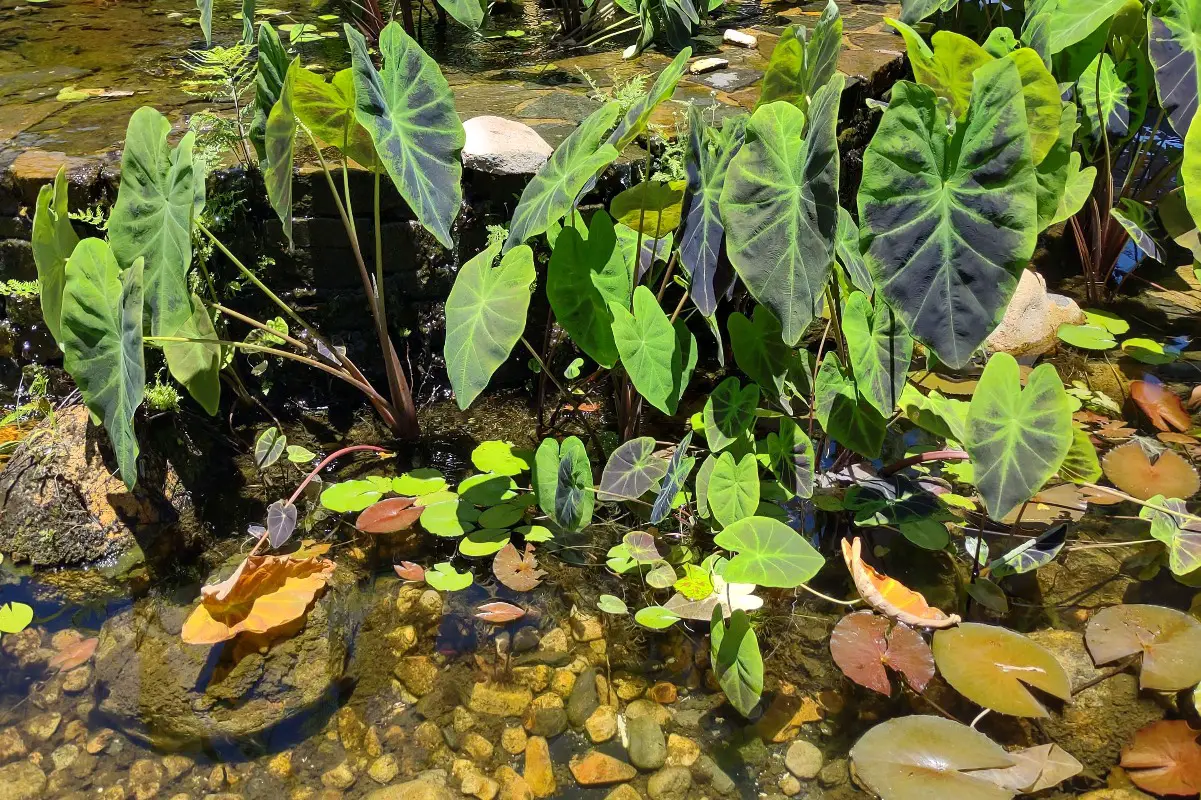
There are many plants that you can grow in a water-filled pot, including those you can buy at your pet store for indoor aquaria.
Also try your local garden centre or nursery, particularly if it has an aquatic section.
My personal favourite is lotus, water lotus, these make a stunning display of leaves rising from the pot, as in this example below.
I now have water lotus in with my guppies and platys but this plant was difficult to source.
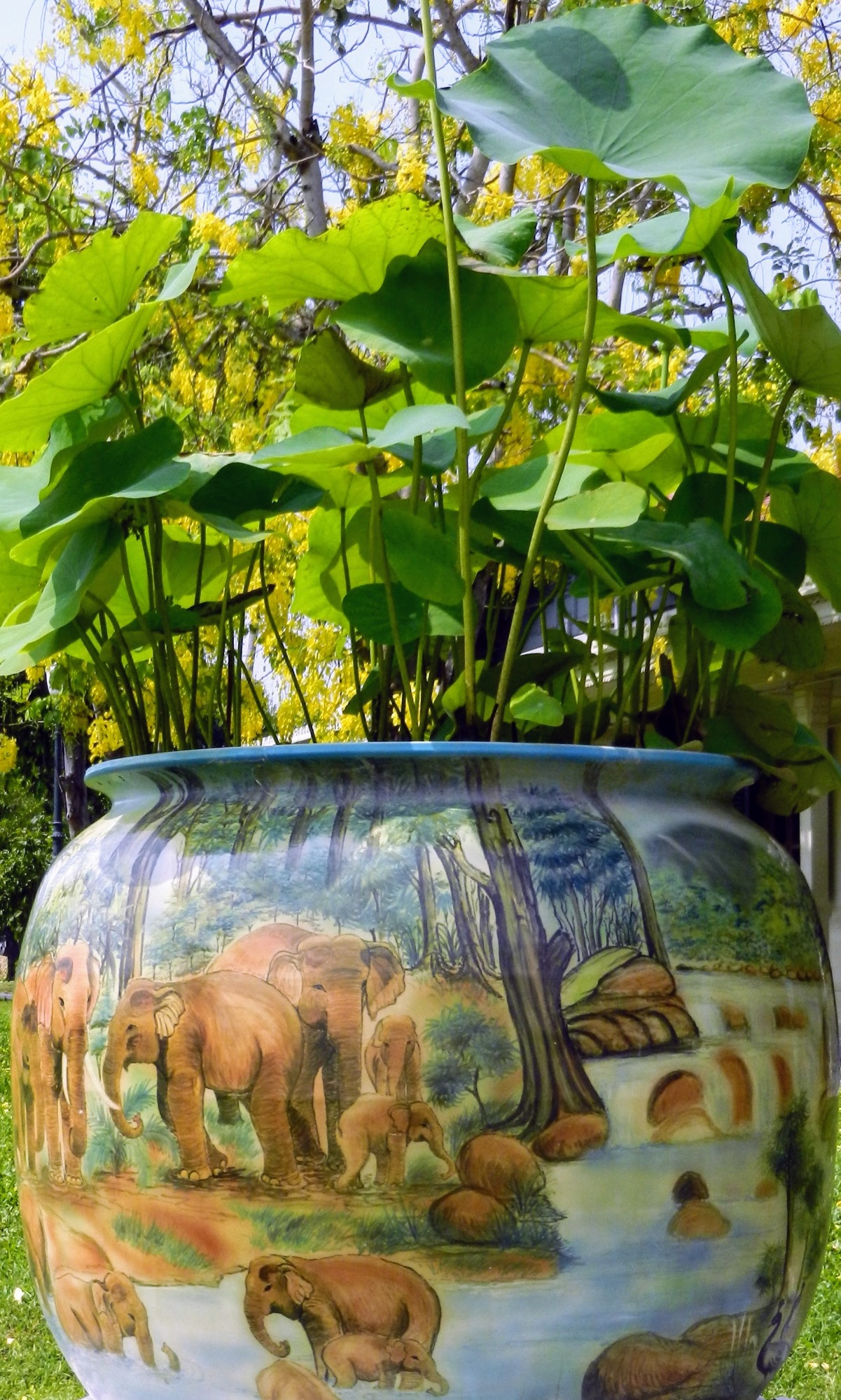
Lotus Pot Temperature Requirements
The water lotus plants in your guppy pot or plant also require fairly high temperatures to grow and to flower. You can’t grow lotus flowers in a cold climate. You’ll need a temperature between 75 and 87F (23 to 30C )and a pot at least 12 inches deep, ideally. If you are in a very hot desert climate, they may need shade in summer, but generally, to blood, they require full sun, full sun is normally over 6 hours of direct sun per day.
The Americal lotus (Yellow lotus,Nelumbo lutea) is of course, native to Florida and the East Coast, this perennial aquatic plant tolerates a wider range of growing conditions, it can be grown in USDA hardiness zones: 2–11 according to the University of Florida.
Algae in Guppy Water
We ran into an algae problem after moving house with our guppies and platys. After years of having a very low maintenance guppy pond, we had water green, and opaque with algae.
The water on our new farm comes from a bore, a well, it is not chlorinated but is potable. We know the mineral composition of our water because we have paid $500 for full water testing. It contains minerals and is safe for human consumption.
We believe these extra minerals are nourishing the algae.
We’ve looked into buying algae-eating companion fish but the water is so full of algae that they won’t be able to effectively control it.
The guppie pot is also overpopulated. We’re moving at least half of our guppies out into other containers around the farm. We’ve had some fish in an animal drinking trough for months, and they’re surviving just fine.
They’re also helping us control mosquitoes.
The usual advice in controlling algae in an outdoor fish pond is to change or partially replace, the water frequently. This hasn’t helped us at all, the algae comes back in days even after a full water change.
The bubbler has also not helped us control the algae problem.
You can purchase chemicals to kill algae from a pet store or online. If we can’t get the algae under control, we will be forced to use it. I’ll keep you updated on how this works.
These chemicals to control algae are harsh, I’d rather get rid of the green water naturally if at all possible.
Pond in a Pot Inspiration
Ponds in a pot are common in parts of Southeast Asia, most notably, in Thailand and Bali Indonesia.
Bali-style gardens are very fitting in tropical climates if you can maintain a good level of irrigation, Bali is wet for most of the year.
I’ve included some photos of ponds in pots, taken in Thailand, to inspire your ceramic pot pond planting and fish keeping
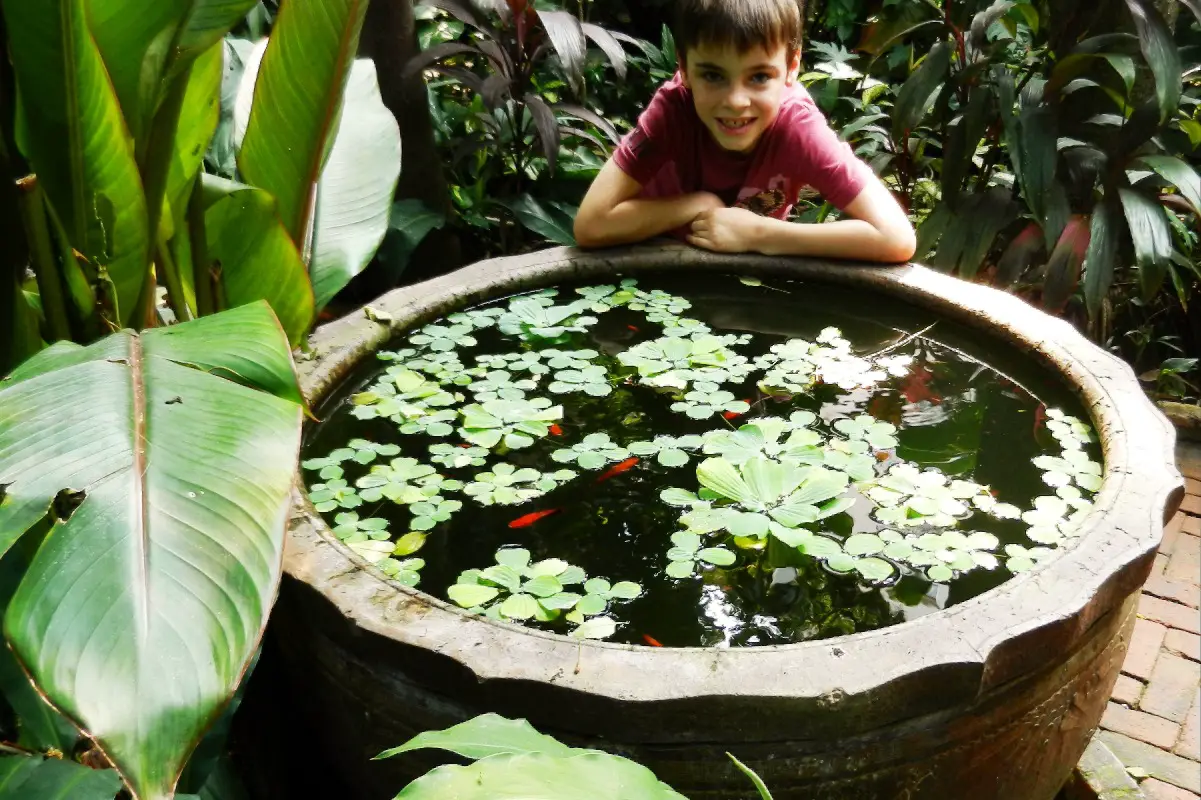
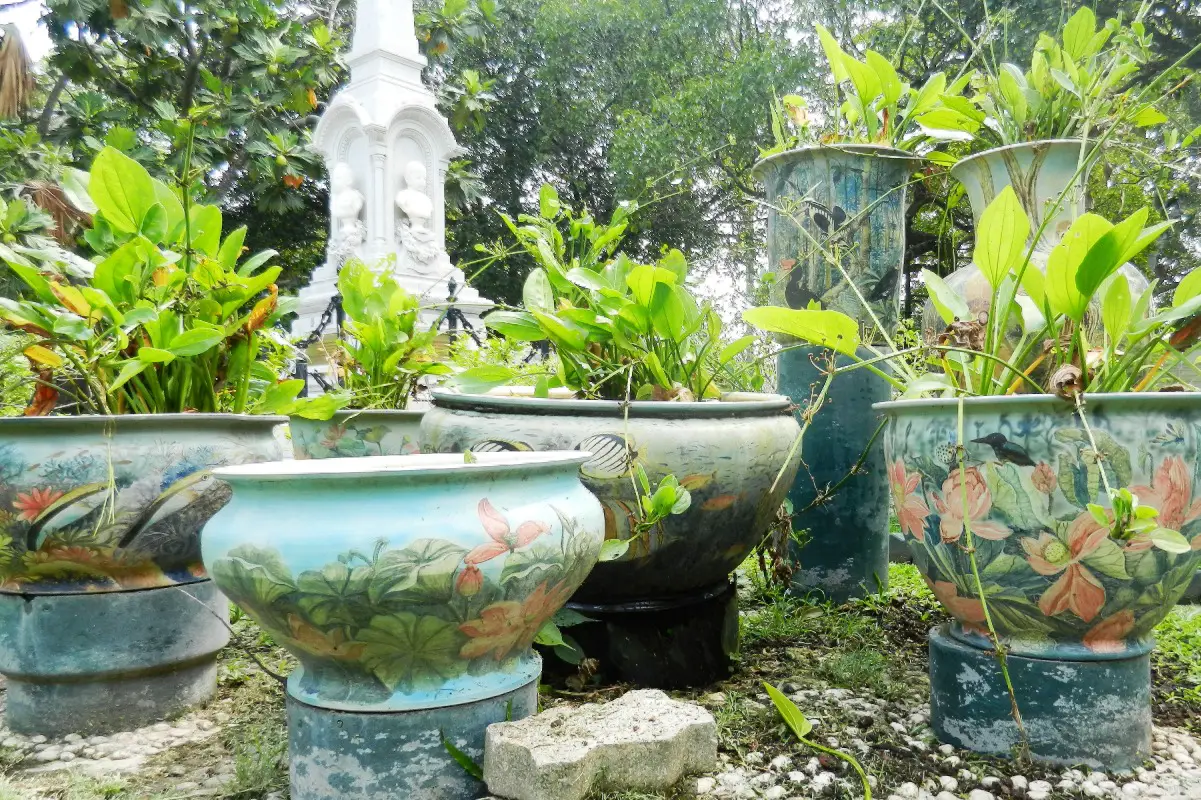
Can Fish Pond Water Be Used To Fertilise Plants?
One of the great advantages of keeping guppies, or any small fish, in a garden pot or pond, is that you have an instant liquid feed for your plants.
Position your pond near plants that need heavy feeding and watering and give your plants a drink of pond water daily. This provides nutrients for your plants and helps keep the fish’s water cleaner.
You will, of course, have to top up your pond with fresh chlorine-free water more often.
This is the basis of aquaponics, using fish to create fertiliser, and plants to clean the water, just in this instance we haven’t closed the loop to recycle the water fully, as you would in a dedicated aquaponics system.
That’s all on keeping guppies outside in pots for now. They’re fun to keep, interesting to breed, and the pot makes a nice decorative feature. It certainly reminds us of our good times in Southeast Asia. Who knows, maybe a larger fish pond and aquaponics will be in our future, we certainly enjoy this first small ceramic pot and our guppy fish seem very happy.